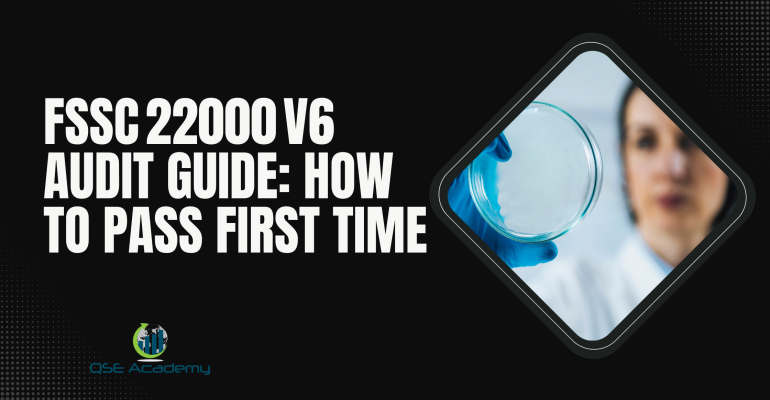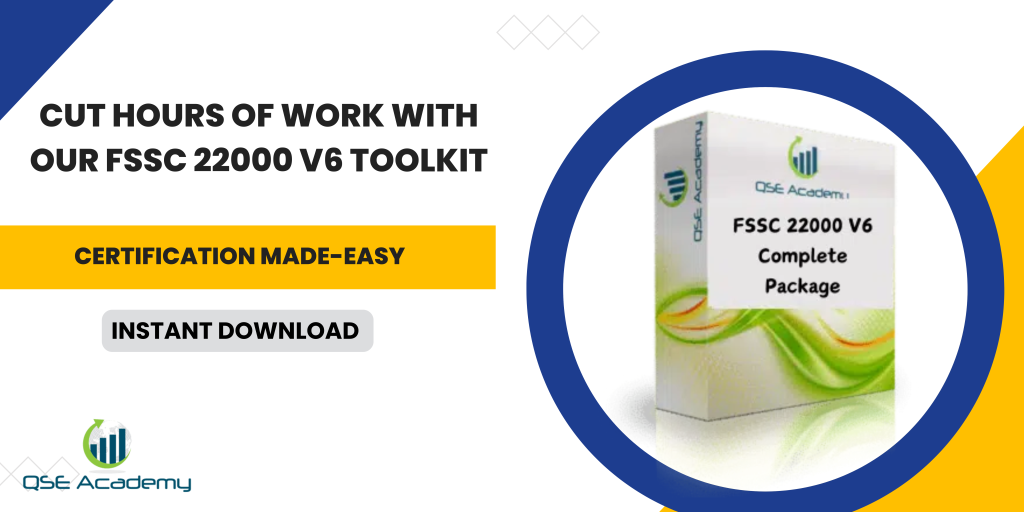FSSC 22000 V6 Audit Guide: How to Pass First Time
A Practical Path to a Successful First Audit
At QSE Academy, we’ve supported organizations of all sizes through FSSC 22000 audits, from first-time certification to surveillance and renewal. One thing becomes clear early in the journey: companies don’t fail because the standard is complicated — they struggle because they’re unsure what auditors expect and how to prepare effectively.
If you’re working toward FSSC 22000 V6 certification, this guide gives you a complete roadmap of the audit journey. You’ll see what happens at each stage, what evidence auditors look for, how to avoid the most common mistakes, and how to confidently demonstrate that your Food Safety Management System (FSMS) is both implemented and effective.
The goal here is simple: help you pass the audit the first time.
Understanding the FSSC 22000 V6 Audit Process From Start to Finish
Before preparation begins, it helps to see the full picture. The FSSC 22000 certification audit isn’t a single event — it’s a structured process with defined steps:
- Application and scope confirmation
- Stage 1 audit (documentation and readiness review)
- Corrective action period, if needed
- Stage 2 audit (full system and implementation assessment)
- Certification decision
- Surveillance and continual improvement
The audit is evidence-based. Auditors verify alignment with ISO 22000:2018, the applicable PRP standard (ISO/TS 22002 series), and additional FSSC requirements like allergen management and food safety culture.
It’s important to approach certification as validation of a functioning system — not a theoretical design.
 Preparing Documentation and Your FSMS for Audit Success
Preparing Documentation and Your FSMS for Audit Success
A strong document structure is one of the earliest signs of a mature FSMS. Your documentation should clearly demonstrate:
- Food safety policies and objectives
- Roles, responsibilities, and reporting structure
- HACCP methodology and control justification
- Monitoring, verification, and validation evidence
- Procedures for critical processes and PRPs
- Traceability, recall, supplier control, and training programs
A document-control system is essential. Every document must show status, version, approval, and accessibility. The easier it is for anyone to retrieve up-to-date information, the smoother the audit becomes.
A document index or overview guide helps auditors understand how everything connects. It also helps internal teams maintain consistency.
Internal Readiness: Audits, Management Reviews, and Gap Closure
Before Stage 1, your organization should already have completed:
- A full internal audit covering every clause and PRP
- At least one management review
- Corrective actions from those activities
Internal audits shouldn’t be rushed or done only to meet a requirement. They’re your best opportunity to identify weak points before the auditor does.
A structured corrective-action log is key. It tracks findings, root causes, corrective actions, and verification outcomes. This becomes valuable objective evidence that your system isn’t only operating — it’s improving.
Stage 1 Audit Preparation: Your First Formal Checkpoint
The Stage 1 audit focuses on assessing readiness, system completeness, and alignment between documentation and actual operations.
Auditors typically review:
- FSMS structure
- Scope definition
- HACCP and risk assessments
- Validation and verification records
- PRP procedures
- Training records
- Internal audit and management review results
Some organizations underestimate Stage 1, assuming it’s an informal conversation. In reality, findings from this stage determine whether you progress to Stage 2 on schedule. Treat the session as a structured evaluation with professional expectations.
Stage 2 Audit Expectations: Demonstrating Your FSMS in Action
Stage 2 is where auditors assess implementation. They will observe workflows, interview employees, examine records, and look for alignment between documented intent and actual practice.
Common focus areas include:
- CCP and OPRP monitoring
- Allergen and contamination control
- Traceability and recall simulations
- Equipment calibration and maintenance
- Cleaning and sanitation
- Hygiene zoning and personnel practices
- Supplier and raw-material controls
Employees should be prepared to confidently explain their tasks and how they support food safety — in their own words. The auditor expects consistency, clarity, and evidence.
Managing Non-Conformities: Respond Quickly and Effectively
If findings occur, how you respond matters as much as the finding itself. The response must include:
- A factual description of the issue
- Root cause analysis using a structured method
- Corrective action with responsible ownership
- Evidence demonstrating effectiveness
Closing findings prematurely — without verifying results — is one of the most common reasons companies struggle in surveillance audits.
A clear corrective-action system reduces risk, improves traceability, and strengthens internal accountability.
Common FSSC 22000 V6 Audit Non-Conformities and How to Avoid Them
Across industries, certain patterns repeat during audits:
- Incomplete or outdated HACCP validation
- Missing or inconsistent PRP verification records
- Gaps in food fraud, food defense, or allergen control planning
- Calibration or traceability documentation issues
- Weak internal audit processes or follow-through
- Document versions in circulation that don’t match the controlled master files
Preventing these issues requires consistency — not last-minute preparation. Building review cycles into operations ensures your FSMS stays current, not reactive.
Maintaining Certification After Passing
Certification isn’t the finish line — it’s the beginning of a continual improvement cycle. Ongoing responsibilities include:
- Annual internal audits
- Management reviews
- Surveillance audit preparation
- Continuous improvement tracking
- Document and record currency
- Staff competency development
- Corrective and preventive action monitoring
When these are embedded into the organization’s routine, the next audit doesn’t feel like an event — it feels like validation.
FAQs — Quick Answers to Common Questions
How long does certification take?
Timelines vary by readiness, complexity, and audit findings, but most organizations complete certification within a few months once the system is fully implemented.
What if we disagree with a finding?
Auditors allow discussion and clarification. However, disagreements should be backed by objective evidence—not opinion.
Can we still be certified with minor findings?
Yes. Minor non-conformities can be closed within the assigned timeline before certification is issued.
Conclusion — Confidence Comes From Preparation
Passing an FSSC 22000 V6 audit the first time is achievable when preparation is structured, documentation is controlled, and the FSMS operates consistently throughout the organization.
A successful audit isn’t about memorizing clauses or impressing auditors — it’s about demonstrating that food safety isn’t a project, but a functioning system supported by trained people, reliable processes, and verifiable evidence.
If you’re preparing for certification, QSE Academy provides tools, templates, and support to help you move confidently through each step of the process and maintain compliance long-term.
Melissa Lavaro is a seasoned ISO consultant and an enthusiastic advocate for quality management standards. With a rich experience in conducting audits and providing consultancy services, Melissa specializes in helping organizations implement and adapt to ISO standards. Her passion for quality management is evident in her hands-on approach and deep understanding of the regulatory frameworks. Melissa’s expertise and energetic commitment make her a sought-after consultant, dedicated to elevating organizational compliance and performance through practical, insightful guidance.








